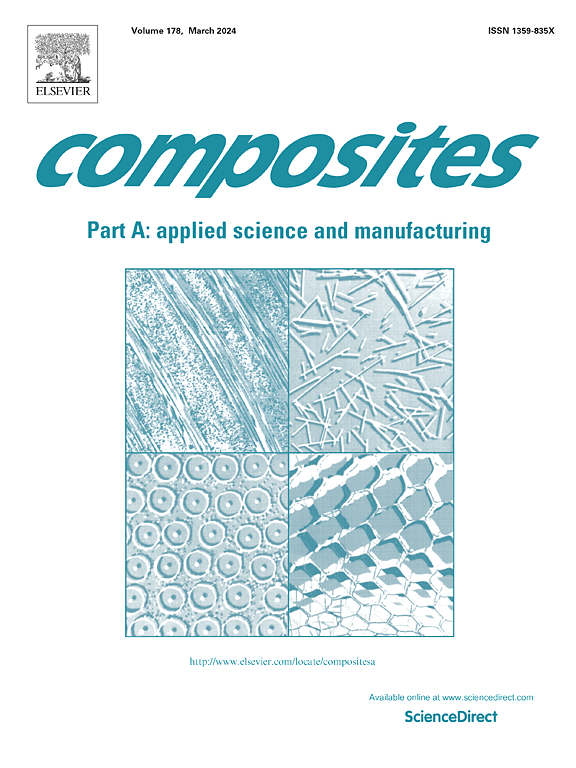Laser powder bed fusion of high-performance carbon fiber reinforced PEEK composites: Process design and orthotropic behavior analysis
IF 8.1
2区 材料科学
Q1 ENGINEERING, MANUFACTURING
Composites Part A: Applied Science and Manufacturing
Pub Date : 2025-05-07
DOI:10.1016/j.compositesa.2025.109013
引用次数: 0
Abstract
Poly-ether-ether-ketone (PEEK) and PEEK-based composites are emerging as key materials in laser powder bed fusion (LPBF) techniques fabricated via selective laser sintering (SLS). In the current work, the process parameters and scanning strategies for LPBF of carbon fiber reinforced PEEK composites (LPBF-CF/PEEK) with a fiber weight fraction of 20 % are studied. The effect of nano-scale SiO2 flow agent content on the powder flowability and the mechanical property of LPBF-CF/PEEK composites is analyzed. Using optimal process parameters, LPBF-CF/PEEK composites with the ultimate tensile strength of 142 MPa and modulus of 11.3 GPa are successfully 3D printed. Further, the orthotropic behaviors of LPBF-CF/PEEK composites are evaluated. Uniaxial tension, compression, and pure shear tests are conducted along three principal directions, i.e., the powder spreading direction, transverse direction, and building direction for LPBF-CF/PEEK composites. Excellent mechanical performance is observed along all loading conditions, except for the tension in the building direction. A macro-scale constitutive model, combining the Liu-Huang-Stout yield criterion and the associated flow rule, is developed to characterize the elastoplastic behaviors of LPBF-CF/PEEK composites. The model is calibrated using the uniaxial loading data of LPBF-CF/PEEK composites, and validated with the LPBF-CF/PEEK structures featuring triply periodic minimal surface (TPMS).
高性能碳纤维增强PEEK复合材料的激光粉末床熔合:工艺设计及正交异性行为分析
聚醚醚酮(PEEK)及其基复合材料是选择性激光烧结(SLS)制备激光粉末床熔合(LPBF)技术的关键材料。本文研究了纤维质量分数为20%的碳纤维增强PEEK (LPBF- cf /PEEK)复合材料LPBF的工艺参数和扫描策略。分析了纳米级SiO2流动剂含量对LPBF-CF/PEEK复合材料粉末流动性和力学性能的影响。通过优化工艺参数,成功打印出了抗拉强度为142 MPa、模量为11.3 GPa的LPBF-CF/PEEK复合材料。进一步,评价了LPBF-CF/PEEK复合材料的正交各向异性行为。对LPBF-CF/PEEK复合材料沿粉末扩散方向、横向方向和构建方向进行单轴拉伸、压缩和纯剪切试验。除了建筑方向的张力外,在所有加载条件下均观察到优异的机械性能。结合Liu-Huang-Stout屈服准则和相关流动规律,建立了表征LPBF-CF/PEEK复合材料弹塑性行为的宏观本构模型。该模型使用LPBF-CF/PEEK复合材料的单轴载荷数据进行校准,并使用具有三周期最小表面(TPMS)的LPBF-CF/PEEK结构进行验证。
本文章由计算机程序翻译,如有差异,请以英文原文为准。
求助全文
约1分钟内获得全文
求助全文
来源期刊

Composites Part A: Applied Science and Manufacturing
工程技术-材料科学:复合
CiteScore
15.20
自引率
5.70%
发文量
492
审稿时长
30 days
期刊介绍:
Composites Part A: Applied Science and Manufacturing is a comprehensive journal that publishes original research papers, review articles, case studies, short communications, and letters covering various aspects of composite materials science and technology. This includes fibrous and particulate reinforcements in polymeric, metallic, and ceramic matrices, as well as 'natural' composites like wood and biological materials. The journal addresses topics such as properties, design, and manufacture of reinforcing fibers and particles, novel architectures and concepts, multifunctional composites, advancements in fabrication and processing, manufacturing science, process modeling, experimental mechanics, microstructural characterization, interfaces, prediction and measurement of mechanical, physical, and chemical behavior, and performance in service. Additionally, articles on economic and commercial aspects, design, and case studies are welcomed. All submissions undergo rigorous peer review to ensure they contribute significantly and innovatively, maintaining high standards for content and presentation. The editorial team aims to expedite the review process for prompt publication.
 求助内容:
求助内容: 应助结果提醒方式:
应助结果提醒方式:


